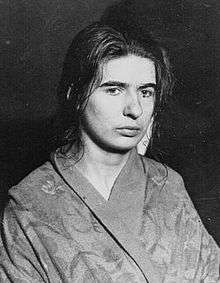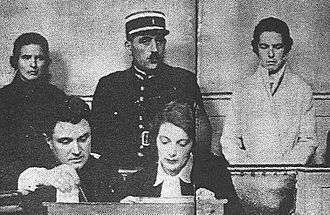Christine and Léa Papin

Christine Papin (8 March 1905 – 18 May 1937) and Léa Papin (15 September 1911 – 24 July 2001) were two French sisters, live-in maids, who were convicted of murdering their employer's wife and daughter in Le Mans, France, on 2 February 1933. This incident had a significant influence on French intellectuals Jean Genet, Jean-Paul Sartre and Jacques Lacan, who sought to analyze it, and it was thought of by some as symbolic of class struggle. The case has formed the basis of a number of publications, plays and films as well as essays, spoken word, songs, and artwork.
Life and crime
Christine and Léa had grown up in villages south of Le Mans. They grew up in an alcoholic household, abused by their father and neglected by their mother. They had an older sister, Emilia, who became a nun. Both of them spent time in institutions as a result of the breakdown of their parents' marriage. As they grew older, they worked as maids in various Le Mans homes, preferring, whenever possible, to work together.
From about 1926, they worked as live-in maids in the home of Monsieur René Lancelin, a retired solicitor, in Le Mans. The family was made up of his wife and adult daughter, who was still living with her parents (another daughter was married). The two maids were extremely quiet and retiring young women, who kept to themselves and appeared to have no interests but each other.
On 2 February 1933, Monsieur Lancelin was supposed to meet his wife and daughter for dinner at the home of a friend. When they did not turn up, he was concerned and went back to their home. He was unable to get into the house because the doors were locked on the inside, but he could see the glow of a candle through the window of the maids' room. He then went to the police and one of them got into the house by climbing over the back wall. Inside, he found the bodies of Madame Lancelin and her daughter. They had both been beaten to the point of being unrecognisable, and one of the daughter's eyes was on the floor nearby. Madame Lancelin's eyes had been gouged out and were found in the folds of the scarf around her neck. The two maids were found in their room upstairs, naked[1] in bed together. They confessed to killing the two women. The weapons used had been a kitchen knife, a hammer, and a pewter pot that had stood at the top of the stairs.
The sisters were placed in prison and separated from each other. Christine became extremely distressed because she could not see Léa, but at one stage the authorities relented and let her see her sister. She threw herself at Léa and spoke to her in ways that suggested a sexual relationship.[1] In July 1933, Christine experienced a kind of "fit", or episode, in which she tried to gouge her own eyes out and had to be put in a straitjacket. She then made a statement to the investigating magistrate, in which she said that on the day of the murders she had experienced an episode like the one she had just had in prison, and this was what precipitated the murders.[1]
The case had a huge impact on the public and was debated furiously by the intelligentsia. Some people considered that the murders had been the result of "exploitation of the workers", considering that the maids worked fourteen-hour days, with only half a day off each week.

Trial and aftermath

The women went on trial in September 1933. Crowds gathered outside Le Mans courthouse and police had to be brought in to control them. During the trial, the women stated that an argument had developed between Christine and the Lancelin women. Léa had then joined in the fray, and Christine had yelled at her to "tear her eyes out" in reference to Madame Lancelin. The daughter had received similar treatment, and Christine had then gone to the kitchen to get weapons that were used to finish the women off. The blows and hacks were directed almost entirely to their heads, virtually obliterating their faces. The maids gouged the eyes out with their fingers.
Christine Papin
Medical testimony given during the trial was that Christine, who was of average intelligence, was completely the dominant person in the relationship. Léa, who was of low intelligence, had been dominated to the point where her personality had virtually disappeared into Christine's personality. There was also a history of mental illness in the family, and their father was alleged to have raped their elder sister, Emilia. The two girls were inevitably found guilty and Christine was sentenced to death. Léa was given the lesser sentence of ten years imprisonment to reflect the fact that her choices had been profoundly manipulated by the influence of Christine. Christine's death sentence was later commuted to life imprisonment, which was common in the case of women. While in prison, she showed acute signs of madness and an intense longing for her sister. She became severely depressed, and frequently would not eat. She was transferred to a mental asylum at Rennes, where she died of cachexia ("wasting away") on 18 May 1937.
Lea Papin
Léa Papin was released from prison in 1943, her sentence having been reduced to eight years because of good behaviour. She then lived in the town of Nantes, where she was joined by her mother and, earned her livelihood as a hotel maid.[2] She was believed to have died in 1982, but this was questioned in 2000 by the French filmmaker Claude Ventura, who made a documentary film, En Quête des Soeurs Papin (In Search of the Papin Sisters), in which he claimed to have found Léa alive in a hospice in France. She was partly paralysed as the result of a stroke and could not speak, although she was shown in the film. Ventura's film claimed that Léa died in 2001.[3]
Works relating to the case
- The Maids (Les Bonnes), a play by Jean Genet
- The Maids, a film based on the play, directed by Christopher Miles
- My Sister in This House, a play by Wendy Kesselman
- Sister My Sister, a film version of the play directed by Nancy Meckler
- Les Abysses, a film directed by Nikos Papatakis
- La Cérémonie, a film directed by Claude Chabrol
- Violets, a 2015 short film directed by Jim Vendiola[4][5][6]
- Les Soeurs Papin, a book by R. le Texier
- Blood Sisters, a stage play and screenplay by Neil Paton
- L'Affaire Papin, a book by Paulette Houdyer
- La Solution du passage à l'acte, a book by Francis Dupré
- "The Murder in Le Mans," an essay in Paris Was Yesterday, a book by Janet Flanner
- La Ligature, a short film by Gilles Cousin
- Les Meurtres par Procuration, a book by Jean-Claude Asfour
- Lady Killers', a book by Joyce Robins
- Minotaure #3, 1933, a magazine
- The Maids, an opera by Peter Bengtson
- Les Blessures assassines (English : Murderous Maids), a film by Jean-Pierre Denis
- En Quete des Soeurs Papin (In Search of the Papin Sisters), a documentary film by Claude Ventura
- Gros Proces des l'Histoire, a book by M. Mamouni
- L'Affaire Papin, a book by Genevieve Fortin
- The Papin Sisters, a book by Rachel Edwards and Keith Reader
- The Maids, an artwork by Paula Rego
- Anna la bonne, a 1934 "spoken song" written by Jean Cocteau and performed by Marianne Oswald.[7] This was inspired by Poe's Annabel Lee rather than the Papin case, but it influences Genet's "Les Bonnes".[8]
- Possibly "Tomorrow," episode 2.2 of the television series Law & Order Criminal Intent
Les Bonnes by Jean Genet
The play Les Bonnes, by French writer Jean Genet, is sometimes thought to be based on the Papin sisters, although Genet himself said this was not the case. However, the play deals with the plight of two French maids who resemble the Papin sisters, and highlights the dissatisfaction of the maids with their lot in life, which manifests itself in a hatred for their mistress. Genet's interest in the crime of the Papin sisters stemmed at least partly from his contempt for the middle classes, along with his understanding of how a murderer could glory in the infamy that came from the crime.
See also
- Popular Front (France), for more on the political climate of the times.
References
- 1 2 3 Dupré 1984, pp. 17–265
- ↑ Edwards & Reader 1984, pp. 4–19
- ↑ Photos of the two Léas; retrieved 24 July 2008.
- ↑ ""Violets" a film by Jim Vendiola". violetsfilm.com. Retrieved 2016-12-20.
- ↑ "Perrier — Introducing the Winners of the 2015 Chicago...". Perrier. Retrieved 2016-12-20.
- ↑ Vendiola, Jim; Jones, Cassandra; Siffermann, Annie (2015-04-24), Violets, retrieved 2016-12-20
- ↑ La travail en chansons Archived March 28, 2012, at the Wayback Machine. Anna la bonne (in French)
- ↑ "Cocteau".
Bibliography
- Dupré, Francis (1984). La solution du passage à l'acte [The solution of acting out] (in French). Paris: Éditions Érès.
- Houdyer, Paulette (1988). L'Affaire Papin [The Papin case] (in French). Paris: Éditions Cénomane.
- Edwards; Reader (2001). The Papin Sisters. Oxford University Press.
External links
![]() Media related to Christine and Lea Papin at Wikimedia Commons
Media related to Christine and Lea Papin at Wikimedia Commons
- En Quete des Soeurs Papin[In Search of the Papin Sisters (2015) FR-4. (in French) ] on YouTube
- Les soeurs Papin[The Papin Sisters (2014) (in French) ] on YouTube
- "Papin Sisters and Other Studies in Crime".